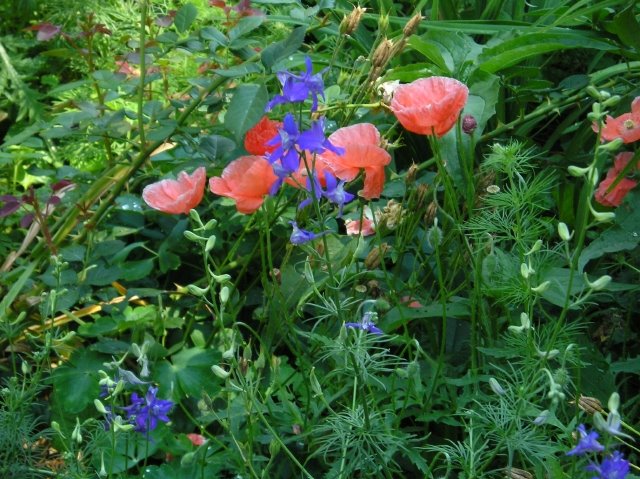Volunteers

Well, here it is Summer already! I just came in from a stroll around my garden, trying to decide what to write about. I restrained myself from doing the container watering that needs to be done today and only yanked a couple of weeds and deadheaded the geraniums and roses that looked a bit ragged. For the most part, the garden is lovely right now. Further weeding and grooming can wait for a bit. I came out for inspiration and didn’t really have to stroll very long before I found it. Volunteers.
You see, I am not a careful weeder, uprooting every plant that I didn’t physically place in that spot. I delight in Nature, the process of life renewing itself and how plants manage to find their niche, grow roots and multiply. Some of them, of course, do it all too well and do get removed in favor of more desirable species. If I let every seedling grow, I would have a yard full of various maples, elms and other trees, poison ivy, etc all growing like weeds on crack. On the other hand, since I do try to look out for that small seedling that is different from the rest, I have two different dogwood trees, a tigerlily, several meadow wildflowers, and a tree that I think might be a Bradford pear, all brought here by nature.
Some annual and biennial flowers naturally self sow themselves around the garden, weaving a lovely tapestry of color around the perennials and roses- foxgloves, larkspur, poppies, columbine, nigella and annual phlox among them. Salvia and nicotiana also reseed themselves here and there, in driveway cracks, or on the edge of a bed. Sometimes the perennials do this too, which is how I came to have a large swamp milkweed growing up in the concrete next to my driveway gate, and chives in a seam by the front porch.
Some of these self-sowers I collect seeds from and start in flats in the house for earlier bloom, and as a result, I’ve noticed that the plants are healthier, and the flowers larger than their commercial greenhouse grown counterparts or seedpacket plants. And every year, they get bigger and better. There is a variety of phlox I grow that originally came from a seed packet called “Phlox of Sheep”, that has become difficult to find in the packet. Since I collect the seeds and grow them under lights each year, I can continue to have those pretty soft colors in my garden. This year I had an equal number of plants volunteer in my larger containers- huge, healthy sturdy plants, just loaded with gorgeous flowers.
This year I am nurturing several different Hosta seedlings I discovered surrounding the diminutive Hosta Venusta I allowed to keep its seed stalks over the winter. Probably nothing too exciting- they have larger rounder leaves, and a deeper color mostly- but one sent up a flowerscape long before any other hosta I grow, and one that sprouted in between some bricks has the tiniest chartreuse leaves that are holding their color really well so far. The whole plant has about a dozen leaves and is only about an inch and a half across. It is so tiny, I had to move it out of the path and into the bed itself to keep it from being trampled into oblivion.
The trick is to really observe those small seedlings and plants. Learn to recognize the newly sprouted seedlings of desirable plants and tell them apart from the true weeds. Let some of those small plants grow for a while until you are able to figure out what they are. You can always pull them out later if they turn out to be undesirable. If you like what they turn out to be- you can leave them there or move them to a more pleasing place. If you really like the plant- let it go to seed for more flowers next year. This season it will have cross pollinated with another color or size of plant, combining their genetic material together in your unique growing conditions to create plants perfectly suited to your garden. At the very least you have free plants, bushes and trees. Isn’t that wonderful?
See you in the Garden!
Ellen Leigh



